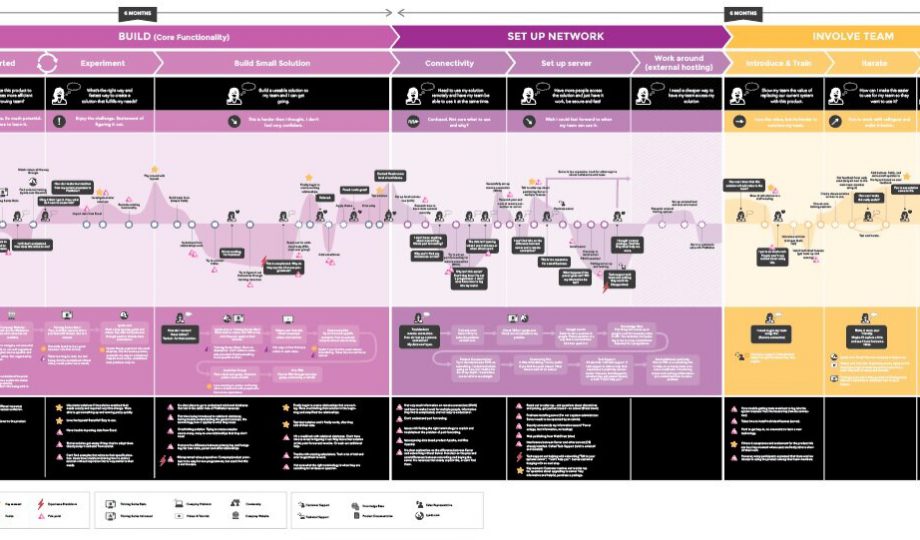Author: Amy Sullivan
Working with government agencies as a UX designer, service designer or design researcher can offer invaluable opportunities to challenge your skills and create work that makes a big difference.
If you’ve landed one of these projects, you might be experiencing a range of different feelings: excitement, inspiration, curiosity… and possibly some worry, overwhelm or fear. Or maybe you haven’t even had time to think about it! (See Miro’s emotional icebreaker, the feelings wheel, to check in with yourself!) As you enter the public sector for the first time, it’s hard to know what to expect, and most importantly, what’s expected of you. There are lots of preconceptions (and misconceptions!) floating around about UX, service design and design research for government projects.
In this first installment of our special blog series, Digital Service Design in Government, we’re busting the three most common myths that design and research practitioners tend to believe about working in government.
AND, as a bonus at the bottom of this post, we’ll also provide a list of resources for UX and service design practitioners looking to collaborate with government agencies, including must-read books, case studies, links to upcoming conferences, etc.
By the end, we know you’ll be ready to dive into that sweet public sector work and discover a whole new world of potential for your practice!
Service Design and UX Projects in Government: The 3 Big Myths
We may know better than to use blanket assumptions when applying a human-centered approach to design, but we sometimes forget that assumptions are a bad idea in general. If you find yourself entertaining preconceived notions about a government design opportunity, it’s important to examine those notions closely and question whether they’re true, so you don’t miss out.
That’s why we’ve rounded up the biggest myths about government design work that get passed around the UX and service design community.
These myths are:
-
- The ‘Impostor Syndrome’ Myth: “Only advanced practitioners can succeed in government.”
- The ‘Old Guard’ Myth: “Government projects aren’t innovative.”
- The ‘Red Tape’ Myth: “Government agencies are slow to evolve.”
We’re eager to analyze and debunk them one by one. Let’s get started!
Design Projects in Government — Myth #1: The ‘Impostor Syndrome’ Myth
“Only advanced practitioners can succeed in government.” FALSE!
Maybe you’re a newer design practitioner who thinks that working in government is too ambitious for your experience level. Or maybe you’ve gained most of your experience in the private sector, and you’re wondering how your experience will transfer over. Either way, the obstacles you’ll face are smaller than they appear. Below are some tips to help you overcome the perceived barriers that make designers, researchers, and other practitioners feel like impostors when entering government project work.
In order to learn the ropes of a government design project, you’ll need to:
-
- Get comfortable with a little discomfort. It’s a perfectly natural reaction to feel overwhelmed when joining a government project. You don’t know the lay of the land, things tend to be incredibly complex, and you don’t yet know how the bureaucracy works. As humans, we get anxious or uncomfortable when we’re in new territory. But if you’re feeling this way, you may be forgetting one key fact: you are competent. Those who hired you believe in you, and they had legitimate reasons for hiring you. Focus on those reasons, and start believing in yourself, too.Reshma Saujani, the founder of Girls Who Code, explains that the origins of impostor syndrome are rooted in misogyny. And while impostor syndrome can affect anyone of any gender, it’s helpful to know that it came from a system created by people. It’s not a force of nature and it can be fought!
- Accept that there will be some confusing jargon. When you team up with a government agency, it’s true that you’re joining a bureaucratic machine. People seem to speak a different language full of new terms and acronyms. But remember, everybody entering the agency goes through the same learning curve. It’s not your responsibility to hide the learnability level for entering government work. (To read more about learnability levels, see Nielsen Norman Group’s article on measuring learnability.
- Don’t be afraid to ask questions. It’s important to be honest about what you don’t know. Asking questions when you’re confused might make you feel awkward and vulnerable at times, but it will help you grow and fit in faster. Not only that, you might reveal the gaps in the onboarding process that others might take for granted. At Outwitly, we’re big on asking proactive questions that can make you stick out from the crowd in a good way.
On the topic of jargon, discomfort, and confusion, here are some typical questions we’ve been asked and responses we’ve heard from our government coworkers and clients over the years:
- Q: “What does ABC mean? I’m not familiar with that acronym.”
- A: “Oh, sorry, I can’t believe that I thought everyone else would know that term. I am so in my own world here!”
- A: “You know what? I’ve been using that acronym for years and I’m still not totally sure what it stands for.”
- A: “Oh yeah, we use several different terms to describe the same thing. Get ready to be even more confused!”
- Q: “I have to admit, I feel quite confused. How long did it take you to feel like you had everything under control?”
- A: “I’ve been here for years and still don’t know everything our Ministry does.”
- A: “I know there are so many unknowns for you, but don’t worry, I’ll help you understand more as things come up.”
- A: “It’ll take you at least six months to get the full lay of the land here.”
Take all of these nuggets with you into your government design projects, and you’ll find yourself with more confidence.
And don’t forget: a good work ethic and an eagerness to learn can go a LONG way when impressing teammates and clients!
Design Projects in Government — Myth #2: The ‘Old Guard’ Myth
“Government projects aren’t innovative.” FALSE!
Sure, it’s true that some public sector agencies and departments rely on outdated technology to run their products and services, especially compared to the tech being used in the private sector.
That’s where the expression ‘old guard’ comes in: a team with seniority becomes resistant to change because their particular tools and strategies have been depended on for many years through many key accomplishments. They can’t always see the benefit of trying something else.
BUT you can take our word for it — government agencies can definitely still innovate and forge new paths in digital service design — with your help, that is! Here are three main strategies for guiding them toward transformation:
-
- Convince teams to embrace the risk of the pivot. Easier said than done, right? This is a crucial part of moving forward in any sector, and it can be tricky. But getting teams used to the idea of change will remove resistance along each step of the way to design transformation. You’ll be off to a good start if you:
- Use diplomacy: Work on finding the right voice and tone for speaking up about innovation in your government agency. Are you coming off friendly, helpful and constructive? Or are you starting all of your sentences with negatives?
- Build trust: Teams with doubts about the process will benefit greatly from some trust-building on your end. That’s especially true if you’re a consultant or a UX team of one, because, at the beginning, you might be the only advocate for innovation. Building rapport and avoiding surprises is key. Utilize your soft skills of active listening and empathy in these situations. If you really want to set your project up for success and build stakeholder trust, check out our online course, Design Research Mastery. We dedicate an entire module to this topic, and its teachings have yielded amazing results for many digital service designers!
- Seek support: As we mentioned, innovation is possible, and it has been done before! You’d be surprised how often you can find yourself surrounded by design-thinking professionals who’ve been there, and we recommend leaning on them. These could be other design and research practitioners on other projects, or cross-disciplinary team members interested in design. See what strategies they’ve tried, what’s worked well, and what fell flat so you can avoid making the same mistakes. With a little bit of bonding, you’ll be able to benefit from their input.
- Look for ways to work smarter. You may be solving UX or service design problems in a new environment, but that doesn’t mean you have to reinvent the wheel every time. Research the work that others have already done in the public sector, so that you can get familiar with existing approaches. You don’t have to copy them, but they might serve as jumping-off points for alternative solutions. You can look through our guide to conducting desk research here.
- Make use of references. Many who are resistant to change don’t realize that government-based UX and service design communities have been doing innovative work for years! And that work is easily accessible online. (Drum-roll…!) Welcome to the niche world of digital service design for government! These success stories are great for pointers, but you can also use them to show your agency the possibilities that open up when they embrace change. Check out the Observatory of Public Sector Innovation’s Toolkit Navigator: A repo of 33 toolkits and guidebooks on how to do service design for public sector innovation created by government innovators themselves.
- Convince teams to embrace the risk of the pivot. Easier said than done, right? This is a crucial part of moving forward in any sector, and it can be tricky. But getting teams used to the idea of change will remove resistance along each step of the way to design transformation. You’ll be off to a good start if you:
Lastly, remember that your government agency was innovative enough to hire a design professional like yourself in the first place! That means they already see some value in UX, service design and/or design research. It’s time to grab that torch and carry it forward.
Design Projects in Government — Myth #3: The ‘Red Tape’ Myth
“Government agencies are slow to evolve.” FALSE!
Operative communities within the public service like Finance, Policy, Communications and Human Resources tend to have long-established responsibilities, roles, and cultures dating back years and years. But often, there is no Digital Service Design department, so you might be starting from ground zero, and if it does exist, it may still be in its infancy stages – where not all ministries or departments are familiar with the work of designers.
The struggle to make space and time for user experience perspectives is new for most government agencies. Since your goal is to help your clients evolve quickly, it can feel overwhelming when there is so much buy-in to establish first. Maybe you’re also used to dealing with stakeholders who struggle to grasp the relationship between great experiences and their bottom line.
But there’s one very important difference to appreciate when designing in government agencies: your clients, stakeholders and coworkers are all public servants! Everyone in the public sector is aligned with the vision of creating good experiences for the public. Evolving their empathy is easier because empathy is already at the heart of every government agency. No red tape here!
So what now?
Once you realize this freedom, the next obstacle you might face is some overwhelm at all the possibilities. As design-thinkers, we’re familiar with so many best practices, methodologies, templates, etc. Indecision can slow us down, and so can over-ambitious concepts.
The best way to evolve government agencies is to assess the team’s existing relationship with UX and service design and then gradually introduce more advanced or ‘mature’ UX and service design practices.
At Outwitly, we love referring to our Guide to UX Maturity! It allows us to determine an organization’s maturity level so we can work together on the best course of action to ‘level up.’ One of the biggest mistakes we can make as design practitioners is introducing a methodology that doesn’t align with the organization’s goals or our ability to deliver successful user-centered design.
Here are some questions to get you started determining your agency’s UX maturity. We suggest adjusting the tone of your answers and observations to best serve each relationship dynamic.
-
- What is the UX Maturity of this government agency?
- What is the UX Maturity of the development teams within my ministry? (If there are several. We’ve seen ministries with up to 10 teams!)
- What is the UX Maturity of my development team? (This one’s extra important!)
- What is the UX Maturity of my ministry’s stakeholders? (i.e. Finance, Policy, Communications, or HR.)
Helping teams evolve is one of our strengths — and doing so quickly is one of the main reasons we get hired.
Gleaning information from our Guide to UX Maturity can help all teams and stakeholders evolve as fast as possible so that you can focus on providing great government agency services.
Resource Library for UX and Service Designers in Government
We wouldn’t leave you without offering a handful of incredible resources for designers and researchers working in government, as promised! Whether you’re inspired by case studies, or you prefer to dive into a good book, there’s sure to be something to support your experience in the list below.
Case Studies:
- Observatory of Public Sector Innovation – Case Study Library
We strongly recommend these resources to anyone who thinks that governments don’t innovate. (Not only have they innovated, but they’ve also published guides on how you can lead design-thinking innovations in government agencies). You can passively reference and study their work to improve yours, or you can join communities to learn directly from their leadership.
Public Sector Innovation Playbooks:
- Observatory of Public Sector Innovation’s Toolkit Navigator: A repo of 33 toolkits and guidebooks on how to do service design for public sector innovation, created by government innovators themselves.
- British Columbia’s Service Design Playbook and Design Research Guide: Page 18 is a personal favourite for our design team!
Conferences for Government Designers and Researchers in 2023
There are still some conferences for you to catch before the end of the year! Note: Many of these conferences also have incredible design communities you can join and learn from.
- ServDes: July 11th – 14th
- UX Australia: August 22nd – 25th
- SDD Leadership Summit: September 15th – 16th
- SDinGov: September 20th – 22nd
- Service Design Global Conference: October 5th – 6th
- CANUX: November 1st – 4th
- Magnify: November 6th
Books for Public Sector UX and Service Designers
If you’re on the hunt for new books to add to your collection and bring new perspectives to your role, here are some amazing options to get you started:
- The Service Organization: How to Deliver and Lead Successful Services, Sustainably (by Kate Tarling)
We hope this article helps you approach design and design research opportunities in government with new perspectives from those of us who have been there.
At Outwitly, we’re always looking for the big picture. Understanding common misconceptions in the UX and service design industry can help us to dismantle our limiting beliefs and reach greater heights.
We’re also all about building confidence to take on big goals, and we’d hate to see anyone write off a government project that could help them elevate their career. Proving that you can collaborate with government agencies will open more doors to prominent design and research work in both the public and private sectors. Understanding the “what” and “why” behind a government agency’s previous design decisions can be a lot to unpack, but don’t let the myths we’ve outlined above deter you from getting to the bottom of any problem.
So brush off that impostor syndrome, awaken the potential for change in that ‘old guard’ and embrace the inherent empathy of your public servant teammates. We know you’ll be helping them innovate and upgrade their UX maturity in no time.






